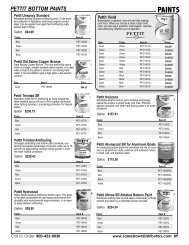technical manu al table of contents - Jamestown Distributors
technical manu al table of contents - Jamestown Distributors
technical manu al table of contents - Jamestown Distributors
Create successful ePaper yourself
Turn your PDF publications into a flip-book with our unique Google optimized e-Paper software.
Question:<br />
Can you explain the differences in terms <strong>of</strong> durability, longevity & appearance between<br />
one-part and two-part varnishes?<br />
Answer:<br />
It <strong>al</strong>l depends on the application. One should <strong>al</strong>ways match the product and its<br />
characteristics to the job.<br />
First <strong>of</strong>f, let’s compare the basic make-up between the two. Single-part products are<br />
gener<strong>al</strong>ly more tradition<strong>al</strong> in their formulation. They contain natur<strong>al</strong> oils like Tung or<br />
Linseed b<strong>al</strong>anced with <strong>al</strong>kyd and/or Phenolic resins as an example. These products rely<br />
on exposure to the air to dry. Two-parts however, are more synthetic (polyesters for<br />
example) and rely on the second part or, the “cat<strong>al</strong>yst” to chemic<strong>al</strong>ly cure the product.<br />
Each produces a very different type <strong>of</strong> coating.<br />
Let’s take appearance. If they are qu<strong>al</strong>ity products, there will be little or no difference<br />
between a high gloss one-part and a high gloss two-part clear finish. The degree <strong>of</strong><br />
gloss will be comparable. However, having said that, gener<strong>al</strong>ly a two-part synthetic finish<br />
will be water clear where as a more tradition<strong>al</strong> one-part will have more <strong>of</strong> an amber tone<br />
to it due to the natur<strong>al</strong> oils. This difference may give you a slight edge when varnishing<br />
very light woods like ash or oak if retaining the lightness is an issue. Beyond that, there<br />
will be no discernable difference.<br />
One-parts are gener<strong>al</strong>ly s<strong>of</strong>ter and more flexible compared with a harder, more scratch<br />
resistant two-part. On an exterior piece <strong>of</strong> wood that is constantly expanding and<br />
contracting with the weather, a s<strong>of</strong>ter more flexible finish is desirable whereas, on an<br />
interior cabin sole or s<strong>al</strong>oon <strong>table</strong> where scratch resistance would be a re<strong>al</strong> plus, the<br />
harder two-part would be a better choice. The flexibility in an exterior finish is extremely<br />
important for longevity. Once a finish loses its flexibility and becomes brittle, that is when<br />
the film begins to break down. Two-parts are certainly used on exterior applications as<br />
well however. They certainly give relief over short-term maintenance (hard finish etc.)<br />
but we do believe that single-part finishes will outlast them over the long haul, as in 10<br />
plus years. That is when you re<strong>al</strong>ly see the difference. In addition, two-parts are more<br />
difficult to repair and remove than one-parts.<br />
There are <strong>al</strong>so single part finishes that are formulated to be to harder than norm<strong>al</strong>.<br />
These contain urethane (harder) resins but still rely on air dry. They can be a great<br />
compromise and sui<strong>table</strong> for many applications where a two-part is too difficult or<br />
unre<strong>al</strong>istic to use.<br />
In conclusion, there is very little difference in the appearance between the two. Twoparts<br />
being a harder finish, will hold up better and longer on high wear areas but, may<br />
not last as long as a one-part in other areas like exterior wood. Single-parts have the<br />
ability to <strong>of</strong>fer a compromise in a finish that is harder than some single-parts, but not as<br />
hard as a two-part.<br />
People are experimenting <strong>al</strong>l <strong>of</strong> the time. We regularly hear <strong>of</strong> two-parts being applied<br />
over a build-up <strong>of</strong> single-part or vice versa. These combinations may or may not work
















